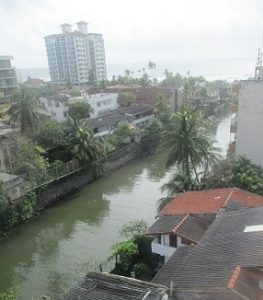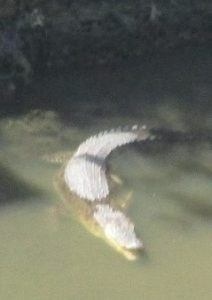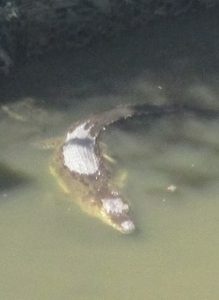
During the seven years I’ve lived in Colombo, capital city of Sri Lanka, I’ve never been far away from the Kirillapone Canal. For the first six years, my partner and I occupied a flat in the street immediately to the south of it. Since late last year, we’ve been in a flat in the street immediately to its north. In fact, our current living-room balcony offers a decent view of its last few hundred metres before it connects with the Indian Ocean.
I’d assumed this waterway was installed by the canal-loving Dutch when they occupied part of Sri Lanka in the 17th and 18th centuries. Having done some research, however, I now know it was created by the British – on the orders of one Charles Peter Layard, the very first Mayor of Colombo and the Government Agent for the Western Province of what was then Ceylon. The canal’s main function was not a transportation or economic one. It was meant to act as a flood-control mechanism for the surrounding area. Later, it transpired that the level of the canal’s bed was higher than that of its catchment area, so that excess water wouldn’t necessarily drain into it. This miscalculation earned it the nickname ‘Layard’s Folly’.
The canal – or at least our stretch of it – is less malodorous than the Dehiwala Canal a mile or two further south, but it still looks polluted and I see a fair amount of gunk floating along it. The city sends guys in boats along it now and then to pull out the trash, but it’s a never-ending battle. Still, despite its less-than-pristine condition, it seems to act as a wildlife corridor. Birds are able to follow it through the city, to and from the sea, without the risk of flying smack into any buildings. The more exotic feathered wildlife I’ve seen in its vicinity over the years include pelicans and, on one surreal occasion, a colourful male peacock that managed somehow to flap up and land on a balcony of our apartment.
Though Colombo often encroaches right to the canal’s edges, there are patches of greenery along it and this seemingly serves as a corridor for land animals too. I’ve been surprised by some of the furry or scaly creatures I’ve seen, living as deeply in the city as we do, and I assume they got here by following the canal. We’ve had monkeys show up on our balconies a couple of times and, on one memorable night, a mongoose did too. Several years back, we saw a sizeable monitor lizard plodding along one of our neighbourhood’s streets in a stately fashion.
A few weeks ago, one morning, I was standing on the living-room balcony when something in the water below caught my eye. There’d been heavy rain the night before and plenty of debris had been flushed seawards along the canal. This apparent piece of debris looked the biggest yet. First of all, I assumed I was looking at a log. However, its shape seemed to curve around and at one end it tapered to a point… Could it be a…? Surely not. I grabbed my camera, zoomed in on the thing, took some photographs and transferred them to my laptop. On the laptop-screen, I realised I had indeed been looking at a crocodile.


I know crocodiles are found in the wilder parts of the island and, when the Portuguese arrived here in the 16th century, Beira Lake – now a prominent feature of cosmopolitan, downtown Colombo – was supposed to be hoaching with the beasts. But I hadn’t expected one to penetrate this far into the city in 2021. The rain of the previous night must have washed him along.
Let’s hope he made it back to his usual territory and didn’t stop to snack on any citizens on the way. Although I doubt very much if anyone would be taking a swim in the insalubrious waters of the Kirillapone Canal.
* A play on the opening lines of the epic poem Tam O’Shanter by Robert Burns.
